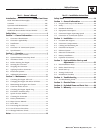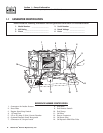
8 Generac
®
Power Systems, Inc.
Section 2 – Operation
PRIMEPACT 50 and 70 (50Hz) Recreational Vehicle Generators
2.4 BEFORE STARTING THE ENGINE
NOTE:
Instructions and information in this manual
assume the generator has been properly installed,
connected, serviced, tested and adjusted by a
qualified installation technician or installation
contractor.
2.4.1 INSTALLATION
Generator installation must have been properly com-
pleted so it complies with all applicable codes, stan-
dards and regulations and with the manufacturer's
recommendations.
2.4.2 ENGINE LUBRICATION
Have the engine crankcase properly serviced with the
recommended oil before starting. Refer to Section 1.6.3
(Page 6) and Sections 3.1 and 3.2 (Page 11) for oil ser-
vicing procedures and recommendations.
Any attempt to crank or start the engine before
you have properly serviced it with the recom-
mended oil may result in an engine failure.
2.4.3 FUEL SUPPLY
The engine must have an adequate supply of proper
fuel to operate. Before starting it, check that sufficient
fuel is available.
NOTE:
Depending on the installation, the generator may
have either a separate fuel tank, or it may “share”
the vehicle engine’s fuel tank.
2.4.4 COOLING AND VENTILATING AIR
Air inlet and outlet openings in the generator com-
partment must be open and unobstructed for contin-
ued proper operation. Without sufficient cooling and
ventilating airflow, the engine/generator quickly over-
heats, which causes it to shut down and may damage
the generator.
2.4.5 ENGINE EXHAUST GAS
Before starting the generator engine, you should be
sure there is no way for exhaust gases to enter the
vehicle interior and endanger people or animals.
Close windows, doors and other openings in the vehi-
cle that, if open, might permit exhaust gases to enter
the vehicle.
The generator engine gives off DEADLY carbon
monoxide gas through its exhaust system. This
dangerous gas, if breathed in sufficient concen-
trations, can cause unconsciousness or even
death. Never operate the generator set with
the vehicle inside any garage or other enclosed
area. DO NOT OPERATE THE GENERATOR IF THE
EXHAUST SYSTEM IS LEAKING OR HAS BEEN
DAMAGED. SYMPTOMS OF CARBON MONOX-
IDE POISONING ARE (a) inability to think coher-
ently; (b) vomiting; (c) twitching muscles; (d)
throbbing temples; (e) dizziness; (f) headaches;
(g) weakness; and (h) sleepiness. IF YOU FEEL
ANY OF THESE SYMPTOMS, MOVE INTO FRESH
AIR IMMEDIATELY. IF SYMPTOMS PERSIST, GET
MEDICAL HELP.
2.5 STARTING THE GENERATOR
To start the generator from either the generator con-
trol panel or from the optional remote panel, proceed
as follows:
1. Turn OFF electrical loads using the means pro-
vided in your vehicle (such as a main line circuit
breaker or transfer switch).
NOTE:
If starting from the generator control panel, turn
OFF loads by setting the generator’s main circuit
breaker to the OFF (or open) position. If starting
from a remote panel, turn OFF loads using the
means provided in the vehicle (such as a main cir-
cuit breaker). Electrical load circuits will be
turned ON after the generator has started, stabi-
lized and warmed up.
2. If you have not started the engine in more than
two weeks, press the Fuel Pump Primer switch
and hold it for about five seconds to prime the
fuel system. However, if the engine is warm, skip
Step 2.
3. Hold the engine Start/Stop switch in the START
position to crank the engine. Release the switch
when the engine starts.
If the engine does not start after it has been
cranking for 15 seconds, release the Start/Stop
switch and try again. Holding the switch for
longer than 15 seconds can damage the
starter motor.
4. Let the engine run at no-load for a few minutes to
stabilize and warm up.
5. Turn ON electrical loads using the means
provided (such as a main circuit breaker or
transfer switch).
◆
◆
◆
◆
◆


















